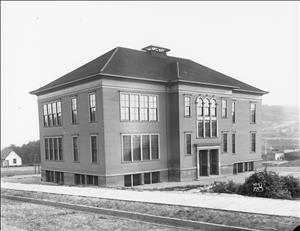This history of Interbay School is taken from the second edition of Building for Learning: Seattle Public School Histories, which includes histories of every school building used by the district since its formation around 1862. The original essay was written for the 2002 first edition by Nile Thompson and Carolyn J. Marr, and updated for the 2024 edition by HistoryLink contributor Casey McNerthney.
Interbay School
Interbay is the lowland area between Smith Cove at the south end of Magnolia Bluff and Salmon Bay just south of Ballard. The Salmon Bay Annex operated there from 1901-1902. The Seattle School District then purchased property for a permanent site at 16th Avenue W and W Barrett Street. The Interbay Annex opened there in December 1902 with two rooms for grades 1-4, still as an annex to Salmon Bay School. A permanent building named Interbay School opened on the site in 1903 with five classrooms for grades 1-8. When Interbay closed in 1939, the students were divided for the following year between Lawton and Coe. The school board was advised to close the school after enrollment declined and only one teacher was needed for three classes in a single room. The lack of modern facilities and its proximity to a garbage dump were also factors.
A garbage dump was established in the Interbay neighborhood in the 1920s and lasted until spring 1962, when the site was paved to create a remote parking lot for the World’s Fair. The dump reopened on and off again until 1965, and in 1967 the site was considered for a stadium that was ultimately constructed south of downtown Seattle and became known as the Kingdome.
The Seattle City Council had promised to create a city park with sports fields, funded in part by an estimated $100,000 from a 1960 park bond (Proposition 2). The fields opened in 1966. Today the larger site is home to the Interbay Athletic Complex, a result of part- nerships between the City of Seattle’s Parks and Recreation, Interbay Golf Center, and Seattle Pacific University. Though only the soccer stadium was built on the land of the former school, the complex also includes a nine-hole golf course, driving range, baseball and softball fields, and a community P-Patch garden.
History
Interbay School
Location: 16th Avenue NW & W Barrett Street
Building: 5-room wood
Architect: James Stephen
Site: 1.76 acres
1903: Opened; renamed Clay on March 7; renamed Interbay on September 1
1939: Closed on June 17; leased for 99 years to parks department
1948: Schoolhouse removed
Present: Site of Interbay Athletic Complex

